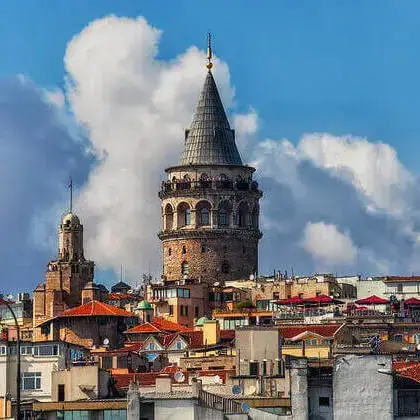The Galata Tower - galata kulesi - is located on the European mainland north of the Golden Horn, overlooking the current Karaköy district - formerly called Galata - connected to the old Stamboul by the Karaköy/Galata bridge.
History of the Galata Tower
The occupation of this hill, dates back to at least the 5th century by the Byzantines. At the beginning, it was only a small village, outside the walls of Constantinople, which constituted the immediate granary of the city with its green pastures and cows – one of the many hypotheses on the origin of its name would come from gala, meaning “milk” in ancient Greek.
Little by little, Galata becomes urbanized. A first tower was built by the Byzantines, which is often confused with the current Galata Tower. This ancient tower was called the Great Tower – Megalos Pyrgos and was located further down, at the mouth of the Golden Horn. It was used as an anchor point for a floating chain which, linked to the walls of Constantinople, closed the entrance to the Golden Horn (which was very practical, it must be said, to keep enemy ships away).
Unfortunately this first tower was destroyed in 1204 when the knights of the 4th Crusade plundered and sacked Constantinople (a strange crusade that had nothing to do with a divine mission!) For your information, you can still see a piece of the chain in the Istanbul archaeological museum and another one, later, in the military museum in the Harbiye district! Recently, you can even see a piece of it in the Galata Tower, the new one!
A few years later, in 1267, when the Byzantine Empire was already weakened, the latter allied itself with the Genoese to whom it granted the possibility of installing a Genoese colony on Galata. In exchange, the Genoese committed themselves to help Byzantium against the numerous enemies coveting Constantinople (notably Latins and Venetians). Little by little the bird makes its nest… the Genoese largely exceed the initial concession, by building ramparts beyond even the limit which was granted to them (where there is Genoa, there is no pleasure!). They built in 1348 at its top, a tower that they called the Tower of Christ – Christea Turris. It is this one that we still visit today in Istanbul!
A century later, in 1453 when the Ottomans maneuvered to besiege Constantinople, the Genoese let it happen… and thus ensured their peace of mind as neighbors with the new occupants. They signed a treaty of submission with the Sultan Mehmet II “to be able to keep their commercial establishments”.

After the fall of Constantinople and during the whole Ottoman period, the district remained that of the Latins and other minorities: Jews, Armenians, Greeks and other Western foreigners. Although the ramparts of Galata were demolished in the 1870s (remains are visible here and there), this Genoese tower has been preserved and restored with some modifications to the roof.
It was used successively as an observatory against fires, prison, astrological observatory. Lately, it was occupied by a panoramic restaurant of the Beltur chain (some kind of cuisine), but it was possible to climb to the top to admire the view. Since October 2020, the Galata Tower has become a national museum. Gone is the restaurant, replaced by a nice model of the city!
Clearly, the Galata Tower is one of the must-see monuments and a symbol of Istanbul!
Description of the Galata Tower

This cylindrical tower culminating at nearly 67m, is built on 9 floors with a panoramic terrace at about 51m which is accessed by an elevator, then some flights of stairs.
Perched on the hill of Galata at 35m above sea level, it has long been the highest monument in Istanbul.
The 360° view is superb! But you will not be the only one, so arm yourself with patience to be able to make your selfie with a view on the tip of the seraglio and the entrance of the Bosphorus!
Legend of the Galata Tower
While visiting the Galata Tower you will hear about the incredible feat of a certain birdman named Hezarfen Ahmed Çelebi.
This Ottoman Leonardo da Vinci, had invented wings, with which he undertook to fly. He flew from the top of the Galata Tower to Üsküdar on the Asian side of Istanbul, flying over the Bosphorus for about 3.5km.
His bet was apparently successful and the event made a lot of noise. The Sultan of the time, Murad IV would have liked to congratulate him but under the influence of his advisers, who must have judged the feat unnatural, he decided instead to exile him to Algeria (at the time, territory of the Ottoman Empire)! He died there quite young at the age of 31.
The story of this feat is today questioned because studies would have shown the impossibility of flying with the wings that Çelebi had made. Then, reality or legend…?
In any case, a small digital animation in the Galata Tower, on the way down, presents Çelebi. You can even try the feat of flying over the Bosphorus!

